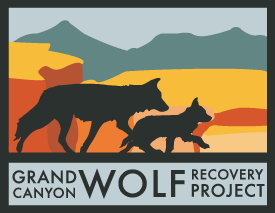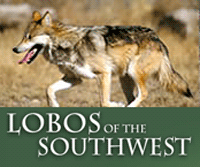The Arizona Republic (Original) Posted January 14, 2016 by Brandon Loomis
Mexican gray wolf supporters say the endangered animals need the Grand Canyon.
Arizona's hard line against expanding Mexican gray wolf territory sets up a battle between those who want to keep the endangered predator away from the Grand Canyon and those who say its survival odds are slim without the new turf.
In November, Gov. Doug Ducey and the governors of New Mexico, Utah and Colorado sent a joint letter to Interior Secretary Sally Jewell and U.S. Fish and Wildlife Service Director Dan Ashe. The governors argued that 90 percent of the wolves' historical range was in Mexico and that "any serious recovery planning effort must include a Mexico-centric approach rather than translocation of the subspecies out of its historical range."
On Thursday, wolf supporters rallied outside the Arizona Capitol and then delivered a petition with 5,500 signatures to the governor's office asking him to reconsider.
While the governors say the wolves have never roamed in the territory north of Interstate 40, wolf supporters say in today's reality — where most former Mexican habitat is private ranch land or otherwise altered — the wolf must look north to find deer, elk and solitude for survival.
They noted that various polls over the last decade have placed Arizonans' support for wolf recovery in the state at more than 70 percent.
"Arizonans want wolves," said Sandy Bahr, the Sierra Club's Arizona chapter leader.
Ed Coleman of Mesa attended the rally and agreed. The retiree said he has seen and heard wolves in their existing recovery zone by a home he owns in Nutrioso.
"There's nothing that gives you goosebumps like the sound of a wolfpack howling in the night," he said.
Mexican gray wolves are a smaller subspecies of the larger wolves that inhabit the northern Rocky Mountains. They were native to Arizona and New Mexico forests before being wiped out in the 20th century.
There were only seven genetically distinct Mexican gray wolves alive in the 1980s. Biologists bred pups in captivity for a reintroduction into the Blue Range overlapping the Arizona-New Mexico boundary starting in 1998.
A year ago, the government counted at least 110 wolves living wild in the two states, which was a modern record and a marked increase from the previous year. Another record is expected when biologists announce their latest annual count this month.
The U.S. Fish and Wildlife Service is attempting to write a long-stalled recovery plan for the lobo. Scientists working on a previously shelved draft suggested a goal of 750 in three connected populations, likely requiring new zones including the forests around the Grand Canyon.
The state has opposed that idea, and the governors' November letter complains that scientists assigned to the latest planning effort are biased toward it.
Where the wolves lived before American settlers and the government hunted them to extinction is a matter of debate, but one that some wildlife advocates say may be irrelevant to the subspecies' survival today. They say wolves have to go where there's room and prey to support them, and the Grand Canyon is a strong candidate along with southwestern Colorado and southern Utah.
"They may be the only places that will work," said Eva Sargent, Southwest representative for Defenders of Wildlife.
Wolf supporters dispute the governors' assertions about historical ranges and point to a new study by a team of evolutionary biologists showing that old wolf specimens found as far north as Utah and Nebraska at least shared Mexican wolf genes, indicating cross-breeding with the northern gray wolves.
Supporters also question whether Mexico really held 90 percent of the habitat, as the governors' claim, or just the last stronghold before captive breeding.
"This (assertion) is based on hunting records from the 1800s and early 1900s," said Emily Renn, executive director of the nonprofit Grand Canyon Wolf Recovery Project. "They had pretty much already been pretty much wiped out through deliberate hunting campaigns in Arizona and New Mexico and farther north."
It's ironic, Renn said, that wolf opponents such as elk hunters want to limit where wolves roam but don't mind shooting elk that were imported from the northern Rocky Mountains after a local subspecies went extinct.
Ducey's staff was not present when Bahr delivered the petition on Thursday and did not immediately respond to a request for comment.
The Arizona Game and Fish Department contends that the bulk of scientific evidence supports a historical range south of the Mogollon Rim and that there's no need to push north.
"It is the department's opinion that recovery is progressing well," said Jim deVos, assistant director for wildlife management.
The Game and Fish Commission also opposes shifting the wolf recovery zone north.
Commission Chairman Kurt Davis said the welfare of other species is at stake. For instance, he said, a subspecies of mule deer native to the Kaibab Plateau north of the Grand Canyon isn't accustomed to Mexican gray wolves.
"You'd be fundamentally altering that ecosystem," he said.
Davis agreed with the governors that there's no proof of historical Mexican wolf range at or north of the Grand Canyon. He said it's a "convenient" argument for wolf advocates to suggest recovery is impossible in Mexico.
A small reintroduced population, perhaps a quarter the size of the American Southwest's, currently lives there.
"Species have been worked on international relationships all the time," Davis said.
Former Game and Fish Commissioner Beth Woodin attended the Capitol rally and said she believes wolves did live at the Grand Canyon and beyond.
"We're putting back a puzzle that's rather incomplete," she said. "Having political squabbles isn't going to help."





